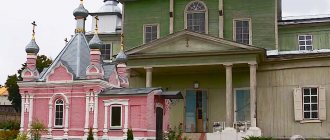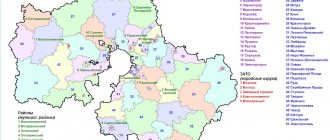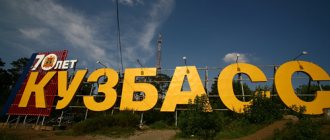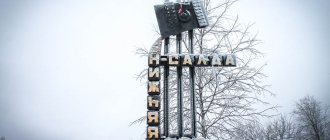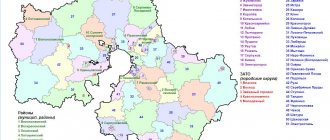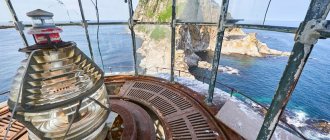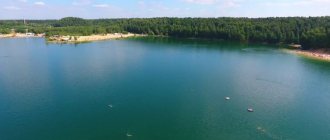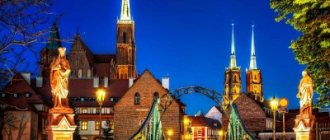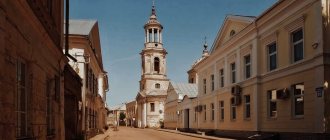Municipalities
Municipality passport
General information about the municipality
The district was created on April 7, 1946 by the Decree of the Presidium of the Supreme Soviet of the USSR “On the formation of the Koenigsberg region as part of the RSFSR” and was called Heinrichswald.
On September 7, 1946, by Decree of the Presidium of the Supreme Soviet of the RSFSR, it was renamed Slavsky with the administrative center in the city of Slavsk, formerly Heinrichswald. On January 1, 2009, the Slavsky district became the Municipal Entity “Slavsky Municipal District”. Today, the Slavsk region has 57 rural settlements, home to 21,338 people; the population of the city of Slavsk is 4,269 people. The administrative center - the city of Slavsk - is located in the eastern part of the region, 120 km from the regional center, covering an area of 1056 hectares. Communication with the city of Kaliningrad and other areas of the region is carried out by rail and highways. The total length of roads in the district is 354.3 km. The largest settlements are: the city of Slavsk, the villages of Bolshakovo, Yasnoye, Timiryazevo, Rzhevskoye and Prokhladnoye.
The date of City Day celebration is the second Sunday of August.
General information about the terrorist departments of the Slavsky urban district
- Bolshakovsky territorial department
- Timiryazevsky territorial department
- Yasnovsky territorial department
- Gastellovsky territorial department
238620, Kaliningrad region, Bolshakovo village, Telmana str., 19 Head of department - Shevchuk Angelika Mikhailovna Contact phone: 8 (40163) 3-76-71. Reception days: Tuesdays and Thursdays, from 9.00 to 11.00
238611, Kaliningrad region, Timiryazevo village, Mira street, no. 12 Head of department – Vitaly Viktorovich Andreechkin Contact phone: 8 (40163) 2-65-45. Reception days: Tuesdays and Thursdays, from 9.00 to 13.00
238613, Kaliningrad region, Yasnoe village, Sovetskaya str. 1 Head of department - Tatyana Petrovna Lukyanova Contact phone: 8 (40163) 2-52-16. Reception days: Thursdays, from 8.00 to 10.00
238602, Kaliningrad region, Gastellovo village, Tsentralnaya str., 73 Head of department - Malakhov Ivan Vladimirovich Contact phone: 8 (40163) 2-34-21. Reception days: Thursdays, from 11.00 to 13.00
Characteristics of economic sectors and infrastructure
Agriculture
The leading industry in the region is agriculture. The main direction is meat and dairy. Agricultural production today employs about 20% of the working population. The agro-industrial complex of the district includes 16 agricultural enterprises and 7 operating peasant farms.
The largest farms in the industry: Pobedinskoye CJSC, Ground LLC, New Vysokovskoye LLC, Berezhki agricultural artel, peasant (farm) farms: Podlesnoye, Zarechye, Voskhod, Dyunnoye CJSC, LLC "Sovkhoz Lermontovsky", LLC "Sovkhoz Ivanovsky", LLC "Agrosystem". There is also a fishing collective farm “Rybak Baltic” in the area.
Industry and small business
The main industrial potential of the region consists of: SPK "Kolyada", GRDK "Rayavtodor", MUP "Vash Gorod", LLC "Kamenets", LLC "Servik", LLC "Melio-plus", LLC "Selkhoztekhnika", JSC "Slavsky Meliorator", Slavsk branch of the Federal State Institution "Management "Kaliningradmeliovodkhoz", Kaliningrad branch of the Federal State Institution "Management "Spetsmeliovodkhoz", LLC "Svepark", LLC "Rudenkov and K", IP "Gvozdenko", LLC "Remontnik" and others.
Education
In the Slavsky district there are 7 schools, of which: 5 secondary, 2 basic. Students - 2147 people. There are 442 children in 11 kindergartens. Children receive additional education in municipal institutions:
- House of Children's Creativity - 45 clubs with more than 500 students;
- music schools in Slavsk, village. Bolshakovo, village Clear;
- sports school for children and youth, the following main sections operate: basketball, Greco-Roman wrestling, volleyball, chess, bodybuilding, which are attended by 352 children.
Healthcare
The network of medical institutions in the district is represented by the following treatment and preventive institutions: hospitals - 3: Slavskaya - with 90 beds, Bolshakovskaya, Yasnovskaya; polyclinic in Slavsk; 21 rural medical and obstetric centers; 5 pharmacies and 1 pharmacy kiosk. The Slavsk Central Regional Hospital is one of the oldest rural hospitals in the region; medical care is provided to the population here by 4 departments: surgical, therapeutic, gynecological and children's.
Culture
The network of cultural institutions is represented by 8 Houses of Culture and 16 clubs. Leisure activities for urban youth are organized by youth. There is a teenage club “Spectrum” in the city. The population of the district is served by 24 libraries, 22 of which are located in rural areas, with a book collection of 257.7 thousand copies.
Tourism industry
The tourism industry of the region is in its infancy and development. In 2007, a tourist information center building was built in Slavsk, whose staff will help you obtain any tourism-related information. A 65 km long bicycle route has been created, and more than 40 tourist information boards have been installed along the roads. Today, several private guest hunting houses are available to tourists: “Pait”, “Irina”, “Lesnaya Polyana”, “Losiny Les” - local residents will be happy to offer you their estates for relaxation with simple rural services: accommodation, meals, a Russian bathhouse, fishing, water and hiking trips, seasonal hunting.
A municipal program for the development of tourism in the Slavsk region for 2015–2020 has been created, within the framework of which tourist routes will be implemented in the region and in the city of Slavsk, a souvenir shop will be created at the tourist center and many other events.
There are three archaeological sites in the Slavsky region:
- settlement "Oktyabrskoe" - approximately V - X centuries, opened in 1982;
- settlement "Rzhevskoe" - dates back to the early Middle Ages (9th - 14th centuries), opened in 1982;
- The Rzhevskoye ground burial ground dates back to the 1st - 13th centuries AD, opened in 1928.
Architectural monuments of the 17th - 20th centuries are registered in the area, including:
- Russian-German cemetery of two world wars 1914, 1941-1945.
- Concentration camp "Hochenbruch" - 1939 - October 1944.
- Church of the 18th century in the village of Bolshie Berezhki (1675-1703)
- Church ХYIII p. Timiryazevo (1740).
- Church of the 19th century in Slavsk (1867-1869).
- Church of the 18th century in the village of Bolshakovo (1773).
- Church of the twentieth century in the village of Bolshakovo (1925).
- Church of the late 19th century in the village of Zapovednoe (1891-1896).
- Church of the 18th century in the village of Yasnoe (1704-1706).
- Church of the late 19th century in the village of Leninskoye (1894-1896).
- Ruins of a 18th-century church in the village of Vysokoye (1768-1769).
- Ruins of a church of the early twentieth century in the village of Gromovo (1905)
- Ruins of a 18th-century church in Prokhladnoye (1753).
- Ruins of a church from the early twentieth century in the village of Gastellovo (1902-1903).
- Swimming pool with mineral water in Slavsk, built in 1935.
- Goering's dacha - hunting lodge "Pait" in the village of Khrustalnoye, late 19th century.
- Residential building (XX century) in Yasnoye st. Central, building 11.
- Residential building (late 19th century, priest's house) in Yasnoye, st. Streltsova, 1.
- Building in Slavsk on the street. Sovetskaya, house 28.
- Music school in Slavsk - (an architectural monument of the early twentieth century).
- The building of the late 19th century district hospital in Slavsk (1891).
In the district there are more than 30 objects of historical, scientific, artistic or other value, of which 23 are architectural monuments. Soldiers who died in the district during hostilities in 1945 are buried in 10 mass graves. In the city of Slavsk and on the estates of former collective farms, monuments to the Soviet era have been preserved: Kirov (Pridorozhnoye), Kalinin (Bolshie Berezhki), Gastello (Gastellovo), Chernyakhovsky (Rzhevskoye), academician Timiryazev (Timiryazevo), Lenin - in the city of Slavsk, the villages of Bolshakovo , Sovetskoye, Yasnopolyanka, Yasnoye, monument to the Fisherman in Mysovka. In the area there are 4 monuments of German times: 2 burials of Russian soldiers of 1914: in the city of Slavsk in the old German cemetery, behind the current clinic, and 2 km from Slavsk - at the fork in the Slavsk-Timiryazevo-Rzhevskoye roads; in the village of Timiryazevo, not far from the ruins of the church, there are fragments of a memorial sign to the fallen German soldiers in the war of 1914-18; in the forest Mayskoe - a monument to the forester Wilhelm Borchardt.
The drawbridge across the Rzhevka River on the forest road Gross-Skaisgirren (Bolshakovo) - Lauknen (Gromovo) was built at the beginning of the 20th century; the lifting mechanisms, driven manually using lever devices, have been preserved.
By 1867, the old wooden church in Heinrichswald (Slavsk) had become so dilapidated that it had to be closed and demolished. In its place, on June 17, 1867, construction began on a new huge temple in the Gothic style, completed on October 15, 1869. The new church, majestic and beautiful, became a real decoration of the city.
In 1902, a brick church building in the Romanesque style with a powerful facade and a high tower was built in Gross Friedrichsdof (Gastellovo).
The grand opening of the church in Zeckenburg (Zapovednoye) took place on June 1, 1891. The tower and spire of the church were completed only in 1896.
In the summer of 1760, a wooden church built in 1635 burned down from a lightning strike in Neukirch (Timiryazevo). Soon, with the help of the Prussian king Frederick the Great, a new church was built - a massive building with thick walls of more than one meter, its length is 70 meters, width is 20 meters, height is 10 meters. Having stood for about 230 years, this church suffered the same fate: it burned down on April 24, 1995.
The foundation of the church in Rautenskirch (Bolshie Berezhki) was laid in 1675 by the widow of Count Philipp von Hitz, who in the history of this area is known as Louise Katharina von Rauter. Completed 28 years later - June 24, 1703. Byzantine style, built according to sketches of the church in Constantinople.
In 1896, a solemn consecration of a church built in the Romanesque style took place in Weidenau (Leninskoye). German and Lithuanian services were held here.
The first wooden church in Popelken (Vysokoe) was erected in 1640, and in 1768-1769 a new brick church was built in its place. The wooden roof ridge was replaced in 1901 with a 40-meter bell tower.
Ecological situation
The volume of discharge of contaminated wastewater is 6.2 million cubic meters. The volume of harmful substances released into the atmosphere is 0.1 thousand tons. Land contamination with pesticides and mineral fertilizers has not been observed for more than 10 years; contamination with radioactive and toxic substances has not been established in the entire history of the district.
The improvement in the environmental situation over the past decade is explained by a sharp reduction in the use of mineral fertilizers and pesticides in agriculture, and a reduction in the number of livestock and cultivated agricultural areas. Due to lack of funding, the construction of environmental facilities in the district has not been carried out recently.
Huge tracts of forest along the coast of the Curonian Lagoon, large swamps, many rivers, lakes, canals, which are habitats for many wild animals, rare plants and birds, are of great interest to biologists, ornithologists, and ecologists. Within the framework of the Neman River Delta project, cooperation has begun with the Danish Wildlife Foundation.
Explored and extracted natural resources on the territory of the Moscow Region
In the Slavsky region, deposits of building materials and raw materials (sand, clay) are most common. There are peat deposits.
International and cross-border cooperation
Cooperation agreements:
Rasseiniai district self-government, Republic of Lithuania - Agreement on the establishment of friendly relations between the self-governments of the Raseiniai district of the Lithuanian Republic and the administration of the Slavsk district of the Kaliningrad region of the Russian Federation dated September 6, 2003. Protocol – agreement in 2004. https://www.raseiniai.lt/
Silute district municipality, Republic of Lithuania - Partnership agreement dated March 23, 2012 within the framework of the implementation of the international large-scale project “Construction of treatment facilities and sewer networks, as well as construction of water supply networks in the border areas of the Kaliningrad region and Lithuania.” Cooperation agreement dated November 12, 1998. https://www.silute.lt/
Shilali District Municipality, Republic of Lithuania - Cooperation Agreement dated August 3, 2013. Partnership agreement dated March 23, 2012 within the framework of the implementation of the international large-scale project “Construction of treatment facilities and sewer networks, as well as construction of water supply networks in the border areas of the Kaliningrad region and Lithuania.” https://www.silale.lt/
Ronneby, Sweden - Agreement on sister city relations dated November 11, 2000. https://www.ronneby.se/
County of Bentheim, Germany - Partnership Agreement dated September 28, 2002. https://www.grafschaft-bentheim.de/
mass media
Since 1948, a regional newspaper has been published in Slavsk; over its half-century history, the newspaper has changed three names: “Collective Farm Glory”, “Leninsky Path”, and since November 1993 - “Slavskie Novosti”. Published 3 times a week, circulation 1700 copies.
Investment activities
Construction of facilities included in the Federal Target Program for the development of the Kaliningrad region for the period until 2022.
In accordance with the Federal Target Program for the Development of the Kaliningrad Region for the period until 2015, in July 2013, construction began in Slavsk of 2 capital construction projects:
- “Transfer to natural gas of the 2nd stage of consumers in the city of Slavsk, Kaliningrad region”
- “Construction of sewerage treatment facilities with networks in the city of Slavka, Kaliningrad region,” with a total funding limit from federal, regional and local budgets, as well as funds from the European Union with a total funding limit in the amount of 286.857 million rubles.
The project for the project “Conversion to natural gas of the 2nd stage of consumers in the city of Slavsk, Kaliningrad region” provides for the gasification of 437 residential buildings.
The project of the object “Construction of sewerage treatment facilities with networks in Slavka, Kaliningrad region” provides for the construction of 4.6 km of sewerage networks with a diameter of 200 mm to 300 mm along five streets of the city of Slavsk, as well as the construction of sewerage treatment facilities with a general capacity (treatment of domestic wastewater) in a volume of up to 1000 cubic meters per day.
Slavsky district is located in the northern part of the Kaliningrad region. The northwestern border runs along the shore of the Curonian Lagoon, in the east, along the Neman , the region borders on the Republic of Lithuania, in the southwest - on the Polesie region, in the south - on the Chernyakhovsky region. The district includes one urban and 3 rural settlements. The administrative center is the city of Slavsk .
The area of the district is 1349.0 sq. km. The population of the district in 2010 was 21,657 people.
The Slavsky district is a history that we have inherited, and unique monuments, practically undamaged by the war. In Prussia, Heinrichswald (now Slavsk ) was the largest center for fish production and livestock raising; there were rich fields, many farms, a convenient transport network and even its own railway line. Heinrichswalde is a resort town known throughout Europe. There was a hospital with salt springs (one spring still functions today). There are still reserves of healing thermal water: at a depth of 1930 meters, the water temperature reaches plus 73 degrees. A unique combination of natural protected areas and pre-war engineering infrastructure, a dense network of highways, mineral reserves used in construction and energy - all this went to the Kaliningrad region in its original form. The villages were intact, the houses were unauthorized, and even the irrigation system was functioning.
The city of Slavsk was founded in 1292 as the village of Heinrichswalde .
1670 – 1674 – construction of a dam from Skopen (Mostovoye) to Zeckenburg (Zapovednoye).
1673 – construction of the Rautenburg castle was completed (village Malinovka Yasnovsky co).
1686 - a wooden church was built in Heinrichswald .
1700 - an octagonal wooden church building was erected in Inza (Pharleys).
1703 - in the 15th year of the reign of King Frederick I of Prussia, the construction of the temple in Rautenskirch (Bolshie Berezhki settlement), one of the most beautiful religious buildings in the region, built in the Byzantine style, was completed, later it would be called the “pearl of East Prussia.”
1704-1708 - a massive church building without a tower was built in Kaukemen (Yasnoe), the tower was completed in 1881 - 1884.
1709-1711 - a terrible plague epidemic, most of the region's population died, many estates and farms stood abandoned, villages were half empty.
1722 - a cobblestone church , in 1898-1899 the building was expanded in the neo-Gathic style.
1738 - Heinrichswalde came under the patronage of the Prussian king.
1745 - a church was built from cobblestones in Schackendorf (Levoberezhnoe), the tower was completed in 1855 - 1856, restored in 1929.
1756 -1763 - during the Seven Years' War, the inhabitants of Heinrichswalde swore allegiance to the Russian Empress.
1768 -1769 - a church made of stone and brick , a 40-meter tower was completed in 1901.
1773 - a rectangular church building was built from cobblestones in Kreuzingen (Bolshakovo).
October 28, 1818 - Heinrichswalde ( Slavsk ) became the center of the district.
1867 - church began Heinrichswald .
1891 - construction of a church began in Zekenbugra (Zapovednoe village), in 1894 an organ appeared in the church, 1896 - the church tower was completed, two bells appeared on it. Heinrichswalde is connected by rail to Königsberg and Tilsit. 1893 – On April 1, Central European Time was introduced in Königsberg and its provinces.
1894-1896 - a church building in the New Romanesque style was built in Pokraken (Leninskoye).
1900 - Heinrichswalde acquires the importance of a climatic resort.
1902 - a new church building with a high tower was erected in the village of Gross Friedrichsdorf (Gastellovo village).
1903 - the church building in the village of Gross Friedrichsdorf (Gastellovo village) was illuminated, and in the same year an organ appeared in the church.
1904 - Emperor Wilhelm II arrives at the Pait hunting lodge (near Khrustalny).
1905 - a church building in the Gothic style was built in Hohenbruch (Lauknen - Gromovo).
1907 - Emperor Wilhelm II rests in Pait.
On September 9, 1914, at about 3 o'clock in the afternoon, a detachment of the Russian army occupied Heinrichswalde ( Slavsk ); on September 12, Russian troops retreated to Tilsit, leaving the city.
1922 - a church was built in Govarten (Derzhinskoye).
1925 - a new church (next to the hospital).
1932 - construction of the church in Skeren (Gorodkovo) began; on January 6, 1933 the church was illuminated.
1939 - Heinrichswalde , with a population of 3,500 people, received city status.
On January 19, 1945, at 4.00 in the morning, the commander of the 1st Tank Corps, Lieutenant General V.V. Butkov, gave the order to the 44th Motorized Rifle Brigade to occupy Popelken (Vysokoye village), the village was taken in battle. At 17.00, an order was received from the commander of the 3rd Belorussian Front, Army General Chernyakhovsky, to capture the important strategic point of Gros Skasgirren (Bolshakovo village) by the morning of January 20th.
On January 20, 1945, at 3.00 am, the forces of 89 and 117 tank brigades and 44 motorized rifle brigades began an attack on Gros Skasgirren, by 6.00 the village was taken, throughout the day on January 20 the Germans counterattacked 9 times, but were repulsed. The 263rd Infantry Division of the Red Army was stationed in Heinrichswald under the command of Colonel Korniliy Georgievich Cherepanov, later Major General, Hero of the Soviet Union.
On April 7, 1946, the Heinrichswald district was formed with its center in the city of Heinrichswald .
1948 - daily railway service Kaliningrad - Polessk - Bolshakovo - Slavsk - Sovetsk was resumed.
On November 3, 1966, a ceremonial reburial of the remains of the fallen soldiers took place in a mass grave in the center of Slavsk .
On August 5, 1995, in the park of Slavsk , with the participation of Bishop Panteleimon of the Baltic, the foundation stone was laid for the building of the first Russian Orthodox Church in the area.
The Slavsky district is simply a unique, historically established place for the development of the tourism industry. Fans of fishing and hunting for noble game knew it back in the 19th century, when the highest-ranking and eminent people of Germany and Europe came here to take a break from government affairs and hunt, and the Pait hunting lodge was a favorite vacation spot of Kaiser Wilhelm II. These places are not lacking in natural resources even today: huge wild forests, untouched by man, the largest in the Kaliningrad region and picturesque swamps, meadows, numerous rivers, lakes, canals, still rich in game and fish, environmentally friendly air and water.
The climate of the area is temperate maritime, due to the proximity of the Baltic Sea . Winter is short, with slightly negative temperatures. The average temperature in January is -3...-5 degrees. Average July temperatures are +16…+17 degrees. Rainy and cloudy days begin from mid-October, during this period there is an increase in westerly winds, which bring with them dank and cool weather.
The region is characterized by a high saturation of small rivers and lakes. 33 rivers and watercourses flow through the region. All of them belong to the Curonian Lagoon basin and are of the first and highest category in fisheries, they are places for spawning of valuable commercial fish species (bream, pike, roach, smelt, etc.) and feeding grounds for young animals. The largest water arteries of the region are the rivers: Neman - 60 km long, Nemanin - 46 km, Zlaya - 67 km, Matrosovka - 35 km, Muchnaya -28 km, as well as the Matrosov Canal - 43 km. But still, the main river is not only district, but also the entire Kaliningrad region is the Neman .
The rivers are home to whitefish, bream, pike, roach, pike perch, eel, fisherman, crucian carp, salmon, catfish, tench, kulezha and other types of fish.
The territory of the district is included in the zone of so-called mixed forests. And yet it has its own distinctive feature - beech, ash, hornbeam, oak are more widely represented in the forest stands, and to a lesser extent - elm, maple, and elm. Coniferous species include pine, spruce, and larch; fir and cedar are less common. Among the soft-leaved species, birch, aspen, alder, linden, poplar, and tree willow are widespread. Hardwood species include oak, ash, hornbeam, and maple. Among the rare tree species found in the area are Weymouth pine, gray pseudosuga, thuja inanta, red oak, horse and edible chestnuts.
Three environmental state reserves have been created in the area: “Dyunny”, “Gromovsky” and “Zapovedny” . Today under their protection there are 44 species of rare plants that have survived only in some places, of which 34 are on the verge of extinction, and 16 species of animals. Only here, in these remote places, inaccessible to humans, can you still find such rare birds as the white-tailed eagle, black stork, eagle owl, crane, kingfisher, golden eagle, lesser spotted eagle, golden plover, black grouse, hazel grouse. Elk, deer, wild boar, roe deer, wolf, fox, badger, raccoon dog, otter, mink, polecat, and beaver live here.
A large colony of gray heron nests in the area. Every spring, white storks build their nests on the roofs of houses, trees, and near human habitation.
At the service of tourists today are the hunting house "Pait", the hotel "Renata", the hotel "Phoenix", local residents will be happy to offer you their estates for relaxation with simple rural services: accommodation, meals, Russian bathhouse, fishing, water and hiking trips, seasonal hunting.
Communication with the city of Kaliningrad and other areas of the region is carried out by rail and highways. The total length of roads in the district is 354.3 km.
The Slavsk-Novy station of the Kaliningrad railway is located in Slavsk This station belongs to the Kaliningrad-Sovetsk railway line.
The nearest Russian airport accepting international flights is Kaliningrad Khrabrovo Airport (KGD) located 120-140 km from the city (if you drive along different highways).
There are 28 objects in the area that are of historical, scientific, artistic or other value. The soldiers who died in the region during the fighting in 1945 are buried in 9 mass graves in the villages of Gastellovo, Vysokoye, Bolshakovo, Prokhladnoye, Okhotnoye, Timiryazevo, Razdolnoye, Yasnoye and in the city of Slavsk. In the village of Desantnoye, a monument was erected to the reconnaissance paratroopers who operated during the Great Patriotic War in the territory of what is now the Kaliningrad region.
The main attractions of the area include:
- Burial of Russian and German soldiers - Slavsk , st. Sovetskaya, southeast of the church across the road;
— Burial of Russian soldiers - restored. in 2004 ( Slavsk , 2 km northeast of the city);
- Gross Friedrichsdorf School - 1933 (Gastellovo village).
Three archaeological sites:
- settlement "Oktyabrskoe" - approximately 50th century;
— the settlement “Rzhevskoye” — dates back to the early Middle Ages (IX-XIV centuries);
- Rzhevskoye ground burial ground - dates back to the 1st-13th centuries AD.
Hotels in Slavsky district :
— Guest house “Renata” — Bolshakovo village, st. Lermontova, 2, (tel. +7 (40163) 3-76-61, +7 (40163) 3-76-43);
— Hunting lodge “Pait” — Khrustalnoye village (tel. +7 (4012) 45-29-60,);
— Hotel “Henik” — Slavsk, st. Shkolnaya, 7, (tel. +7 (40163) 3-10-31);
— Guest house “Lesnaya Polyana” - Sosnyaki village, 13 - located away from large cities and noisy highways (tel. +7).
Official website of the district: www.slavsk.info
